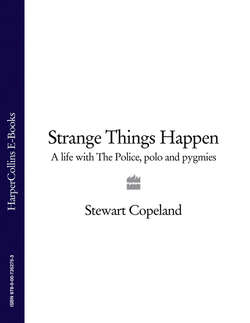Читать книгу Strange Things Happen: A life with The Police, polo and pygmies - Stewart Copeland - Страница 10
1985
NIEBAUM RANCH, NAPA VALLEY
ОглавлениеFrancis leans back heavily and speaks calmly to the producer. The dark screening room is lit by a film frame frozen on the screen.
“Yeah…couple places, we need strings.”
Damn. This had been going really well. As we screened the scenes that I had scored, Francis Coppola had been rumbling with approval. The director and the other postproduction chiefs had been chuckling and nodding sagely over the callow charm of my first attempt at film music. The lack of finesse suited Francis’s sense of atmosphere for this film. Since I had no idea how movies had been scored since the dawn of film I had had to invent the wheel for myself. The important thing was that Francis was able to infuse me with the mood that he needed in each scene. With my bare hands, on guitar, marimba, bass, banjo, and kazoo, I could make that mood.
From the start Francis has been talking about using rhythm as a dramatic device in this film, Rumble Fish. With the classic film High Noon as a template, he wants to build a sense of impending, implacable doom. The story is of a countdown. Matt Dillon, Mickey Rourke, Laurence Fishburne, Dennis Hopper, Diane Lane, and Tom Waits all have an appointment with fate in reel twelve of the movie. Francis wants the audience to sweat every second of the journey to that place.
Well, I don’t know much about drama, but rhythm is a thing of mine. With the help of two teenage Coppolas, Roman and Gian-Carlo, ferreting through the sound effect libraries, I was able to start a collection of rhythms created by machinery, animals, and people. Pile drivers, barking dogs, typewriters, and car crashes all have rhythm if you look closely.
At the Long Branch Studio in Tulsa, Oklahoma, I have recordings of these sounds on magnetic tape. If I cut the tape with a razor at the beginning and end of, say, a burst of dog barking, then I can join the two ends of the strip of tape and create a loop. Threading this loop onto the tape machine is easy enough, but we have to set up tape spools on mic stands around the room to keep the tape untangled as we play the loop and record the repeating pattern of dog barking onto a second tape recorder. One day, a decade or so in the future, someone will invent computers.
The latest breakthrough in audio recording today is technology that can synchronize and dependently lock two tape machines. This enables us to build up a web of sound effect rhythms. By tweaking the speed of the playback machine I can synchronize each new layer of repeating noise to groove in some way with the collection on the recorder.
For every reel of the movie—of which there are twelve—I have a tapestry of rhythmatized and synchronized sounds. On each of eight tracks there is a groove. On track four, for instance, there is a pile driver pounding incessantly. On track six there is a billiard ball break looped to create a strange rhythm. This can be used as a subliminal effect in the pool hall scene. Or to presage the scene, or to refer back to the scene later in the movie. Richard Beggs, who is the overall soundmeister of the movie, is in on the plot. Every scene of the film has a rhythm chugging somewhere in the soundscape. The clock is ticking.
Upon these rhythms I build the music with guitar, drums, banjo, bass, marimba, and piano. There is a scene in which Matt pays an evening visit to his girlfriend, Diane, at her parents’ house. He is met on the front porch by the young Sophia Coppola, who plays the precocious kid sister.
The scene needs to carry the underlying tension of impending, implacable doom but also to lighten up for a minute to play some romance. In the background, the train whistle blows at almost imperceptibly regular intervals. Closer, there is a broken fan that we can feel vibrating. Over these vaguely sinister rhythms a tinkling progression of chords on a toy piano is all it takes to combine with Matt’s yearning performance to create a wave of poignancy.
I have no idea how you are supposed to score a movie, so I just made this whole scheme up as a theory of a practical solution to an artistic problem. It turns out that my method is so far from how you’re supposed to do it that no one has ever done it like this—which makes me the Che Guevara of film scoring.
So far, so good. I don’t even realize yet how rare it is to have a director who will give anyone this much rope. This is the Francis method—find people with the right instincts and turn them loose with the tools.
Now he wants some conventional orchestral score to leaven the rather astringent high-concept layers that I have produced. Violins, oboes, that sort of thing. Some premonition of a career in Hollywood alerts me to a door opening. Strings?
I had already chased off competition from other musicians, arrangers, and composers that Francis had gathered in Tulsa during the shoot. This suddenly looks like a new opportunity for an interloper. Some fool of a studio hack can come on board and sweeten all of my cool stuff! The director wants instruments that I can’t play myself!
In a split second I’m an orchestral arranger.
“Strings?…Sure, yeah, lemme rustle up some strings and nice orchestra stuff in a couple of places,” says I.
